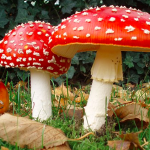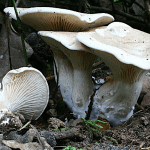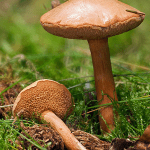Through this piece we’re going to take a look at Where to forage porcini mushrooms.
They can be found growing with Birch, Beech, Oak, Pine, Spruce and Fir, (for the doubters of this out there, my friend found a lovely haul in a predominantly Fir woodland last August after the weather broke).
Happily, for the enthusiast of this mushroom, they can be found throughout the whole of the UK, right up to the north of Scotland.
As well as connecting with several types of trees, there are also some other key mushroom species that can indicate the presence of Ceps, namely Fly Agarics, (Amanita muscaria), The Miller, (Clitopilus prunulus), and Peppery Boletes, (Chalciporus piperatus), especially with Spruce trees. Mark Williams of Galloway Wild Foods states;
Fly Agaric The Miller Peppery Bolete
“I find the relationship between ceps, spruce trees, the miller and the peppery bolete to be so reliable that I believe (though I’ve seen no scientific research to prove this) that the relationship is more than just shared habitat, but a complex interdependency”
It’s a well established fact that Peppery Boletes are parasitic on the mycelia of Fly Agarics, so if there seems to be an abundance of these species, it makes perfect sense to keep your eyes peeled for Ceps too.
Other things to take into consideration are the weather conditions. You’ll generally find Ceps from August to October. If August has been particularly dry and warm, followed by a deluge of rain along with a drop in temperatures, get out there with your basket and go hunting. They like the ground to have been warm, then cooled and flushed with water.
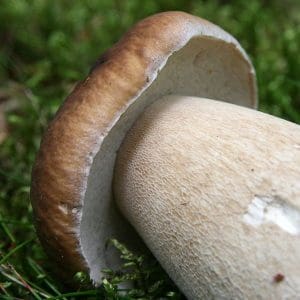
Let’s take a quick look at how to identify the porcini when you’re out foraging…
Here’s our Porcini Foraging Video
Description
A chunky mushroom, with a spongy pore surface under the cap, growing to 8-30cm across and 10-30cm in height.
Cap
Medium brown, 8-30cm across. Looks like a bread roll, hence the English name, Penny Bun. It should be smooth with a white line around the margin. If there are any scales or the texture of the cap feels at all rough, it is not Boletus edulis.
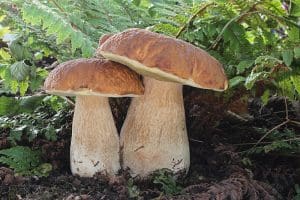
Gills
Has pores rather than gills, which are actually tubes, through which the spores are ejected. Looks a little like a sponge, white when young and turning yellowy green with maturity.
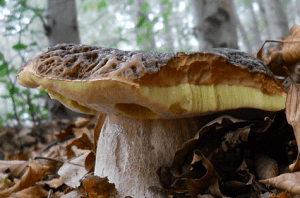
If the mushroom you are looking at has gills, as opposed to pores, then you’ve not found a Bolete.
Spores
Olive brown
Stem
Creamy white, usually very bulbous and often wider than the cap in young specimens. Slightly raised white-on-brown net pattern, called reticulation, around the upper half of the stem.
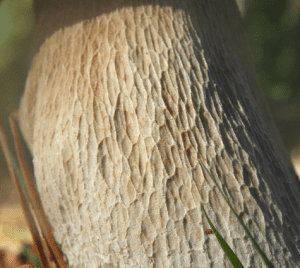
If that reticulation is brown on white, then the mushroom you are looking at isn’t Boletus edulis, but more likely to be a Bitter Bolete, Tylopilus felleus. This mushroom isn’t toxic but is very bitter and contaminates any dish it’s added to.
Smell
Pleasant, savoury mushroom smell. Sometimes you can smell this mushroom before you see it.
Habitat
Boletus edulis is a mycorrhizal fungi, forming mutually beneficial relationships with the trees they grow alongside. In return for helping the trees in their uptake of water, phosphorous, nitrogen and zinc, they receive energy in the form of sugars, from photosynthesis.
Let’s summarise on Where to forage Porcini mushrooms
Ceps are found growing in mixed woodland, particularly with Birch, Beech, Oak, Pine, Spruce and Fir.
If there are Fly Agarics, Millers and Peppery Boletes, you’ll quite probably find Ceps too, especially in Spruce plantations.
They like to incubate in warm August ground, followed by cooling of temperatures and cloud bursts of rain, from August through to October.
Recipes
This mushroom isn’t called Boletus edulis for nothing. There are plenty of other edible mushrooms about to forage, but the excellent flavour of Ceps, both raw, cooked and dried make them truly shine in the kitchen.
There are several excellent wild mushroom recipes in our recipes section, but here’s one we think showcases Ceps/Porcini particularly well.

Find our Porcini Carpaccio recipe here
References
Moser, M; Keys to Agarics and Boleti, Roger Phillips.



